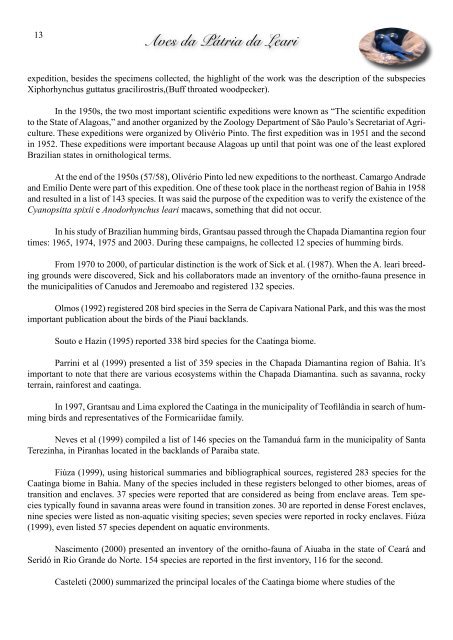Aves da Pátria da Leari - Sociedade Brasileira de Ornitologia
Aves da Pátria da Leari - Sociedade Brasileira de Ornitologia
Aves da Pátria da Leari - Sociedade Brasileira de Ornitologia
You also want an ePaper? Increase the reach of your titles
YUMPU automatically turns print PDFs into web optimized ePapers that Google loves.
13<br />
<strong>Aves</strong> <strong>da</strong> <strong>Pátria</strong> <strong>da</strong> <strong>Leari</strong><br />
expedition, besi<strong>de</strong>s the specimens collected, the highlight of the work was the <strong>de</strong>scription of the subspecies<br />
Xiphorhynchus guttatus gracilirostris,(Buff throated woodpecker).<br />
In the 1950s, the two most important scientific expeditions were known as “The scientific expedition<br />
to the State of Alagoas,” and another organized by the Zoology Department of São Paulo’s Secretariat of Agriculture.<br />
These expeditions were organized by Olivério Pinto. The first expedition was in 1951 and the second<br />
in 1952. These expeditions were important because Alagoas up until that point was one of the least explored<br />
Brazilian states in ornithological terms.<br />
At the end of the 1950s (57/58), Olivério Pinto led new expeditions to the northeast. Camargo Andra<strong>de</strong><br />
and Emílio Dente were part of this expedition. One of these took place in the northeast region of Bahia in 1958<br />
and resulted in a list of 143 species. It was said the purpose of the expedition was to verify the existence of the<br />
Cyanopsitta spixii e Anodorhynchus leari macaws, something that did not occur.<br />
In his study of Brazilian humming birds, Grantsau passed through the Chapa<strong>da</strong> Diamantina region four<br />
times: 1965, 1974, 1975 and 2003. During these campaigns, he collected 12 species of humming birds.<br />
From 1970 to 2000, of particular distinction is the work of Sick et al. (1987). When the A. leari breeding<br />
grounds were discovered, Sick and his collaborators ma<strong>de</strong> an inventory of the ornitho-fauna presence in<br />
the municipalities of Canudos and Jeremoabo and registered 132 species.<br />
Olmos (1992) registered 208 bird species in the Serra <strong>de</strong> Capivara National Park, and this was the most<br />
important publication about the birds of the Piauí backlands.<br />
Souto e Hazin (1995) reported 338 bird species for the Caatinga biome.<br />
Parrini et al (1999) presented a list of 359 species in the Chapa<strong>da</strong> Diamantina region of Bahia. It’s<br />
important to note that there are various ecosystems within the Chapa<strong>da</strong> Diamantina. such as savanna, rocky<br />
terrain, rainforest and caatinga.<br />
In 1997, Grantsau and Lima explored the Caatinga in the municipality of Teofilândia in search of humming<br />
birds and representatives of the Formicarii<strong>da</strong>e family.<br />
Neves et al (1999) compiled a list of 146 species on the Tamanduá farm in the municipality of Santa<br />
Terezinha, in Piranhas located in the backlands of Paraiba state.<br />
Fiúza (1999), using historical summaries and bibliographical sources, registered 283 species for the<br />
Caatinga biome in Bahia. Many of the species inclu<strong>de</strong>d in these registers belonged to other biomes, areas of<br />
transition and enclaves. 37 species were reported that are consi<strong>de</strong>red as being from enclave areas. Tem species<br />
typically found in savanna areas were found in transition zones. 30 are reported in <strong>de</strong>nse Forest enclaves,<br />
nine species were listed as non-aquatic visiting species; seven species were reported in rocky enclaves. Fiúza<br />
(1999), even listed 57 species <strong>de</strong>pen<strong>de</strong>nt on aquatic environments.<br />
Nascimento (2000) presented an inventory of the ornitho-fauna of Aiuaba in the state of Ceará and<br />
Seridó in Rio Gran<strong>de</strong> do Norte. 154 species are reported in the first inventory, 116 for the second.<br />
Casteleti (2000) summarized the principal locales of the Caatinga biome where studies of the

















